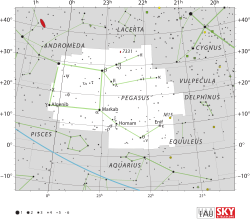Eta Pegasi
| Observation data Epoch J2000.0 Equinox J2000.0 | ||
|---|---|---|
| Constellation | Pegasus | |
| Right ascension | 22h 43m 00.13743s[1] | |
| Declination | +30° 13′ 16.4822″[1] | |
| Apparent magnitude (V) | +2.95[2] | |
| Characteristics | ||
| Spectral type | G2 II + F0 V[3] | |
| U−B color index | +0.57[2] | |
| B−V color index | +0.86[2] | |
| Absolute magnitude (MV) | –1.18[6] | |
Semi-amplitude (K1)(primary) | 14.37 km/s | |
| Details | ||
| η Peg A | ||
Gyr | ||
| Database references | ||
| SIMBAD | data | |
Eta Pegasi or η Pegasi, formally named Matar /ˈmeɪtɑːr/,[11][12] is a binary star in the constellation of Pegasus. The apparent visual magnitude of this star is +2.95,[2] making it the fifth-brightest member of Pegasus. Based upon parallax measurements, the distance to this star is about 214 light-years (66 parsecs) from the Sun.[1]
Nomenclature
η Pegasi (Latinised to Eta Pegasi) is the star's Bayer designation.
It bore the traditional name Matar, derived from the Arabic سعد المطر Saʽd al Maṭar, meaning lucky star of rain.[13] In 2016, the International Astronomical Union organized a Working Group on Star Names (WGSN)[14] to catalogue and standardize proper names for stars. The WGSN approved the name Matar for this star on 21 August 2016 and it is now so entered in the IAU Catalog of Star Names.[12]
In Chinese, 離宮 (Lì Gōng), meaning Resting Palace, refers to an asterism consisting η Pegasi, λ Pegasi, μ Pegasi, ο Pegasi, τ Pegasi and ν Pegasi.[15] Consequently, η Pegasi itself is known as 離宮四 (Lì Gōng sì), "the Fourth Star of Resting Palace".[16]
Namesake
Properties
The Eta Pegasi system consists of a pair of stars in a binary orbit with a
The secondary component is an
References
- ^ S2CID 18759600.
- ^ Bibcode:1966CoLPL...4...99J.
- ^ doi:10.1086/313152
- Bibcode:1953GCRV..C......0W.
- .
- ^ Bibcode:2000A&A...361..614P
- ^
- ^ S2CID 119427037.
- ^ doi:10.1086/117702
- ^ "eta Peg". SIMBAD. Centre de données astronomiques de Strasbourg. Retrieved 2012-03-03.
- ISBN 978-1-931559-44-7.
- ^ a b "IAU Catalog of Star Names". Retrieved 28 July 2016.
- Bibcode:1944PA.....52....8D
- ^ IAU Working Group on Star Names (WGSN), International Astronomical Union, retrieved 22 May 2016.
- ISBN 978-986-7332-25-7.
- ^ (in Chinese) 香港太空館 - 研究資源 - 亮星中英對照表 Archived 2008-10-25 at the Wayback Machine, Hong Kong Space Museum. Accessed on line November 23, 2010.
- S2CID 118803592.

